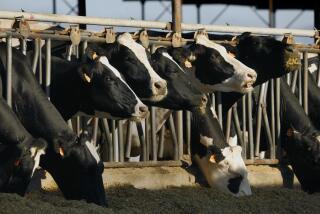Corn Harvest Threatened by Cancer-Causing Toxin
- Share via
CHICAGO — A cancer-causing toxin associated with droughts is infecting some newly harvested corn across the Midwest, raising the possibility of contamination of the nation’s most important grain crop and vital first link in the country’s food chain.
The poison, aflatoxin, is produced by a fungus found in soil. It has been detected in recent weeks in corn samples from at least six states, including the nation’s three biggest corn growing states--Iowa, Illinois and Indiana--which together harvest about 45% of the nation’s corn annually.
“This year is appearing to be a particularly bad one,” said Catherine W. Carnevale, associate director of the Food and Drug Administration’s contaminants policy staff. The problem is unique, she said, because the outbreak is “coupled with a severe reduction in the corn harvested.” The drought is already blamed for wiping out almost 40% of this year’s corn crop.
“This is a hard problem to quantify,” said Nolan Hartwig, head of Iowa’s newly formed aflatoxin task force. “In some parts of the state there are no problems and in others we have major marketing interruptions.”
It could be weeks before state and federal agriculture officials determine how much of this year’s drought-damaged corn crop is infected at dangerous levels. A widespread outbreak could affect food prices because corn is a major component of livestock feed and is used in human foods from cooking oils to cereals. Corn is also a major export crop and contamination could cut into foreign sales.
And for individual farmers unable to sell severely contaminated corn, the aflatoxin outbreak will be yet another costly loss in a decade filled with economic hardships.
“This year we are seeing more (aflatoxin) than we have in the last 10 years,” said Dave Krejci, executive vice president of the Grain Elevator and Processing Society. “It is a particular problem in areas hardest hit by drought,” said Krejci, whose trade group represents grain elevators throughout the country.
If the level of infection is not too severe, much of the grain can be salvaged by being mixed with “clean” or uninfected corn and fed to mature livestock, which are able to tolerate and digest the aflatoxin. Tainted corn can also be used to make ethanol.
Maximum Level for Humans
The FDA has set 20 parts of aflatoxin per billion as the maximum level acceptable for human consumption and 100 parts per billion as the maximum level acceptable for consumption by mature livestock.
While there is only scattered information available on the outbreak so far, preliminary reports are worrisome. For example:
--In Texas, where the first signs of this year’s outbreak were detected last month, 60% to 70% of the fields in the northeast part of the state had aflatoxin levels above those acceptable to the FDA, according to Kenneth Boatwright, director of the Texas Department of Agriculture’s seed and grain warehouse division. A dairy in Sulphur Springs, Tex., was forced to destroy milk from cows fed with contaminated grain, Boatwright said.
--In Iowa, some grain elevators have shut down, refusing to buy newly harvested corn. And elevators that are buying corn are testing every truckload, and often rejecting corn that is believed to be contaminated. The testing is slowing unloading and contributing to longer-than-normal lines of trucks at elevators. Some corn has been tested at levels exceeding 100 parts per billion
--In Illinois, 20 of 54 randomly selected grain samples tested by state chemist Bob Schwarberg were infected with 23 to 73 parts per billion of aflatoxin--levels above those considered safe for human consumption. “But you can’t take that figure and say that 34% of the state’s crop is contaminated,” cautioned Schwarberg, who has just begun testing.
Common Fungus
Aflatoxin is produced by aspergillus flavus, a common fungus or mold found in topsoil. Corn becomes vulnerable in drought years when the dry--and this year the exceptionally hot--weather cracks the kernels allowing the mold to thrive. While the mold itself is relatively harmless, aflatoxin is “a known carcinogen that will produce liver cancer,” said Donald G. White, University of Illinois associate professor of plant pathology.
The presence of mold in corn can quickly be detected by putting grain samples under an ultraviolet or black light. If mold is present the grain glows; contaminated kernels are called “glowers.” But not all that glows is contaminated. The presence of the mold does not necessarily mean the dangerous toxin has been produced. In fact, researchers say that in Iowa this year they are finding about 30% false positives when black light tests are compared with more accurate laboratory tests.
Aflatoxin was first identified as a problem in the early 1960s. There have been several outbreaks, most in the Southeast, where summers are traditionally drier than they are in the Midwest. However there were isolated outbreaks in the Corn Belt in 1980 and 1983 in areas affected by drought. Aflatoxin is also found in peanuts and in cotton.
More to Read
Sign up for Essential California
The most important California stories and recommendations in your inbox every morning.
You may occasionally receive promotional content from the Los Angeles Times.










